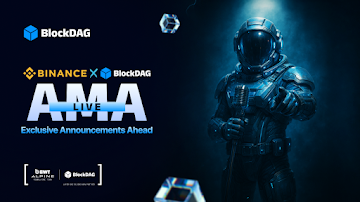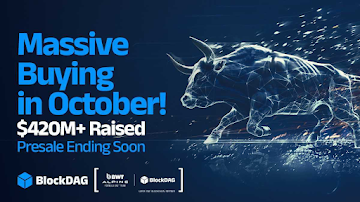What makes a coin stand out for long-term success? Price alone is not enough. Strong networks grow from scalability, decentralization, and efficiency. Past examples like Solana and Avalanche proved that solving problems such as speed and access drives real progress. BlockDAG now joins this path with solid engineering, practical solutions, and growing adoption.
With over $430 million raised and more than 27 billion coins sold, the project is gaining strong momentum. It is currently in Batch 31, priced at $0.0015 for a short time. Alongside, more than 3.5 million X1 miners contribute to the system, strengthening its reach. BlockDAG (BDAG) aims to shape its future ranking through real utility rather than hype, making 2028 a defining milestone.
Learning from Market Growth: The Road to a Top 10 Position
Reaching the Top 10 list by 2028 is not about speculation but about solving real challenges. Coins like Avalanche, Solana, and Cardano advanced by addressing issues like slow transaction speed, scalability, and interoperability. Avalanche created subnets for speed. Solana introduced proof-of-history to improve efficiency. Their growth came from practical solutions, not short-lived trends.
BlockDAG reflects a similar path. It introduces a multi-parent Directed Acyclic Graph design that processes transactions in parallel instead of in order. This reduces delays seen in older blockchains. The project will soon transition from presale to mainnet, which could expand its real-world usability.
Moreover, BlockDAG is preparing for a landmark moment with its upcoming AMA on Binance this Friday, October 24, at 3 PM UTC. The session will deliver insider updates, fresh roadmap reveals, and key insights leading into Keynote 4: The Launch Note and GENESIS DAY. With BDAG still priced at $0.0015 in Batch 31, buyers can use code “TGE” to maximize returns before the dashboard upgrade and price increase.
The current momentum shows promise. If the project maintains this progress, its path may echo those that rose to the Top 20 within two years of launch. With over 3.5 million X1 miners already active, BlockDAG is working on the right pillars: scalability, speed, and decentralization. Achieving further exchange listings and developer adoption may help push it toward its goal.
Infrastructure Strength: Why BlockDAG Could Last
BlockDAG’s foundation is different because it blends Proof-of-Work with DAG processing. Unlike traditional systems, where one block is confirmed at a time, this setup confirms multiple blocks at once. That makes transactions faster without reducing security.
The network supports EVM and WASM compatibility, which lets developers launch smart contracts across environments. This improves flexibility and usability. A notable part of BlockDAG’s system is its Stratum Protocol, which allows millions of X1 app miners and thousands of hardware miners to work together without clogging the network.
Real-time explorer tools give users instant updates on transactions and miner activity. This transparency helps build trust and makes the system reliable. Features like Smart Accounts (EIP-4337) add another layer of long-term functionality.
These details show BlockDAG aims to build a lasting structure rather than quick gains. Its focus on decentralization, miner power, and developer-friendly tools sets it apart. If maintained, these strengths could support steady growth through 2028 and beyond.
Comparing Growth Patterns: From Solana to BlockDAG
Looking at history, networks like Solana and Avalanche saw massive growth once they combined technical progress with community expansion. Solana’s market cap jumped from under $100 million to more than $60 billion as it increased its transaction speed and attracted developers. Avalanche gained traction after securing high-profile partnerships and widening validator adoption.
BlockDAG is following a similar track. With more than $430 million already raised, over 27 billion coins sold, and more than 312,000 holders, it has achieved a strong start before even hitting full exchange listings. Its partnership with the BWT Alpine Formula 1® Team gives it global recognition, extending its influence outside crypto circles.
While Solana and Avalanche depend on staking, BlockDAG relies on miners in its PoW-DAG hybrid system. This creates broader participation and reduces the risks of centralization. Its miner-driven model could prove more resilient as transaction volume grows.
If activity continues to expand across its mining community and smart contract base, it may achieve a Top 25 position within its first year of listing. By 2028, it could enter the Top 10 as adoption increases and exchange growth takes shape. The groundwork already matches the rise of networks that became major players.
Long-Term Outlook: Could BlockDAG Secure Top 10 by 2028?
Three years can transform the crypto world. BlockDAG’s steady growth shows it is not built for short-term spikes but long-lasting adoption. With over 27 billion coins sold and more than 3.5 million X1 miners keeping the network stable, its structure is set for scale.
Progress may come from liquidity through exchange listings and developer expansion. Both are likely steps, given its presale size and miner participation. Its hybrid Proof-of-Work DAG model balances efficiency, security, and decentralization in ways few projects achieve early on.
By 2028, BlockDAG’s mix of strong infrastructure, wide miner distribution, and global brand reach could push it into the Top 10. Its design aims for sustainability and steady growth beyond market cycles.
Presale: https://purchase.blockdag.network
Website: https://blockdag.network
Telegram: https://t.me/blockDAGnetworkOfficial
Discord: https://discord.gg/Q7BxghMVyu
Disclaimer: This is a paid post and should not be treated as news/advice. LiveBitcoinNews is not responsible for any loss or damage resulting from the content, products, or services referenced in this press release.



